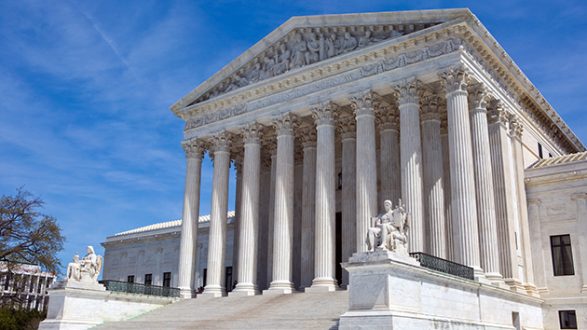
 iStock/Thinkstock(WASHINGTON) — Court battles over President Donald Trump’s revised travel ban continue to be waged across the United States, but two cases have made it to the appeals courts — one in the Ninth Circuit and another in the Fourth Circuit. And now, the fight is on the Supreme Court’s doorstep.
iStock/Thinkstock(WASHINGTON) — Court battles over President Donald Trump’s revised travel ban continue to be waged across the United States, but two cases have made it to the appeals courts — one in the Ninth Circuit and another in the Fourth Circuit. And now, the fight is on the Supreme Court’s doorstep.
On Monday, the Ninth Circuit Court of Appeals ruled to largely uphold a Hawaii court’s nationwide preliminary injunction that blocked the revised travel ban’s 90-day halt on nationals from the six designated Muslim-majority nations and a 120-day suspension of the refugee program. But the Ninth Circuit vacated portions of the injunction that prevented the government from conducting internal reviews of its vetting procedures.
The court affirmed the injunction on statutory grounds — that Trump’s revised ban exceeded the scope of his authority granted to him by Congress — and did not consider the constitutional claims. Earlier in the month, the government asked the Supreme Court to stay the Hawaii injunction.
In a separate case, the Fourth Circuit Court of Appeals ruled in May to affirm a Maryland court’s nationwide injunction of the travel ban’s 90-day stoppage on nationals from six designated countries. Earlier this month, the government asked the Supreme Court to stay the Fourth Circuit ruling — which would temporarily reinstate the travel ban until the Supreme Court can hear the case — to agree to take the case on appeal, what lawyers call a petition for certiorari.
On Monday, the plaintiffs in the Fourth Circuit case filed motions opposing the government’s requests for the Supreme Court to take the case and for a stay.
The Supreme Court could rule on the government’s motions stays of the Fourth and Ninth Circuit rulings at any time, and experts predict that decision could come this week or next. If five Supreme Court justices vote for a stay, the travel ban could be immediately reinstated until the Supreme Court hears the case on the merits, mostly likely in October, when the justices are back in session.
A key issue is when the 90-day ban on travel from the six nations and the 120-day ban on refugees starts and ends. The travel ban challengers claim the 90 days expires this Wednesday, which is 90 days from the revised executive order’s travel ban’s stated effective date of March 16. That interpretation would render the Fourth Circuit’s case moot this week, and the Ninth Circuit’s case moot in another month when 120 days runs out. The government claims that the Hawaii judge’s injunction in March stopped the clock and so the 90- and 120-day periods would not begin to run until the revised travel ban goes into effect.
A vote of four Supreme Court justices are needed for the high court to grant cert and take the case on appeal and to decide if the ban is constitutional. This decision could take longer than the stay, but is expected in a few weeks. If the Supreme Court agrees to hear the case, it likely will be in October, when the Court is back in session.
If a stay is granted and the travel ban goes into effect this summer, the 90- and 120-day periods could expire or come close to expiring by October, which would also make the case moot before the Supreme Court can ultimately rule on the ban’s constitutionality.
However, there’s also the possibility that the Supreme Court could expedite the whole process — granting the certiorari petition this week, hearing arguments in a week or two and deciding the case before the end of the term, although experts say this is an unlikely scenario.
One interim step the government could also take in the Ninth Circuit is ask to for an “en banc” review of Monday’s ruling by all sitting Ninth Circuit judges, but most likely government lawyers will try to go straight to the Supreme Court where the Fourth Circuit case has already landed.
Copyright © 2017, ABC Radio. All rights reserved.










